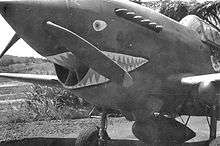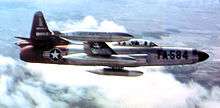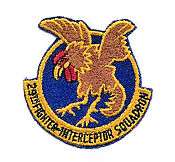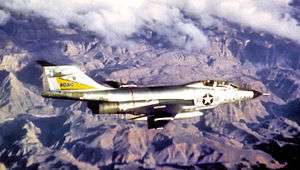29th Training Systems Squadron
| 29th Training Systems Squadron | |
|---|---|
|
29th Fighter-Interceptor Squadron McDonnell F-101B Voodoo near Malmstrom AFB, Montana March 1964 | |
| Active | 1918–1919; 1923-1944; 1944-1946; 1953-1968; 2002-present |
| Country | United States |
| Branch | United States Air Force |
| Engagements |
World War I World War II |
| Insignia | |
| 29th Training Systems Squadron emblem |
 |
The 29th Training Systems Squadron is an active United States Air Force unit. Its assignment is with the 53d Test Management Group, based at Eglin Air Force Base, Florida.
The squadron is one of the oldest in the United States Air Force, its origins dating to March 1918, being organized at Brooks Field, Texas, as a training Squadron during World War I. The squadron saw combat during World War II, and became part of the Air Defense Command (ADC) during the Cold War.
Heraldry
On and over a blue disc bordered golden yellow a gamecock in the position of attack (body, head, neck, wings, and feathers, brown; legs, feet, beak, and eyes, yellow; comb and wattles, red )... (Approved 15 March 1935)
Overview
The 29th Training Systems Squadron has personnel located at Eglin AFB and 11 geographically separated units around the nation: Barksdale, Beale, Creech, Dyess, Hill, Offutt, Robins, Tinker, Tyndall, and Whiteman AFBs as well as an operating location in Mesa, Ariz.
The squadron serves as the Combat Air Force's center of expertise for Aircrew Training Devices (ATD). Squadron personnel provide technical expertise on all aspects of ATD life-cycle management, including acquisition, modification, acceptance testing and certification testing for all A-10, B-1, B-2, B-52, E-3, E-4, E-8, EC-130, F-15C/E, F-16, F-22, F-35, HH-60, HC-130, MQ-1/9, RC-135, RQ-4 and U-2 ATDs.
Unit personnel also manage the CAF Simulator Certification Program. The squadron's efforts incorporate ATD oversight and management from concept development and preliminary design review through sustainment and program deactivation. By keeping training devices concurrent, cost effective and viable, the 29th TSS guarantees training systems meet present and future warfighters' needs while supporting evolving training demands with modern technology.
History
World War I
The squadron was established at Brooks Field, Texas in March 1918. It was an instructional flying squadron, training Air Service flying instructors which would then be sent to other training fields. It was re-designated as Squadron A, Brooks Field, Texas, in July 1918, and demobilized after the end of World War I in November 1918.
Panama Canal Zone
It was reactivated in the Panama Canal Zone at Albrook Field on 1 October 1933. On 6 December 1939, it was re designated as the 29th Pursuit Squadron (Interceptor) and, between 1933 and 1939, had operated, in series, the Boeing P-12, P-26A Peashooter and Curtiss P-36A.


After the Pearl Harbor Attack, the squadron had nine new Curtiss P-40E's, one of the very first Canal Zone units to receive the new fighters, although at least one P-40C was also on hand. The Squadron was placed on General Alert at 15:00, 7 December 1941, at which time all 10 P¬40E's on hand were basically combat ready. Still at Albrook at the time, the unit later was the first to move to Calzada Larga Airfield, Panama (later named Madden Field). The unit was redesignated as the 29th Fighter Squadron on 15 May 1942.
On 29 August 1942, Flight "C" of the squadron was transferred from Madden to remote Talara Airport, Peru, to provide aerodrome defense for the installations there and was relieved there by "E" Flight by December (although this was redesignated as "0" Flight, 51st Fighter Squadron concurrently that month). By January 1943, with the main body still at Madden Field with 18 aircraft, the unit was starting conversion to Bell P-39K Airacobras. By October 1943, still at Madden Field, the squadron also had a flight detached to Aguadulce Army Airfield, Panama. Effective 1 November 1943, with the dissolution of the 16th Fighter Group, the squadron was subordinated directly to the XXVI Fighter Command.
Replacement training
The squadron continued on at Madden Field until 25 March 1944, when the unit was officially transferred to Lincoln Army Airfield, Nebraska and being assigned to IV Fighter Command as a replacement training unit (RTU), flying predominantly P-38 Lightnings.
The squadron was later assigned to California where it was assigned to perform testing of the Bell P-59 Airacomet and Lockheed P-80 Shooting Star jet aircraft based at Muroc Dry Lake (later Edwards AFB). The early jets provided USAAF pilots and ground crews with valuable data about the difficulties and pitfalls involved in converting to jet aircraft. This information proved quite useful when more advanced jet fighters finally became available in quantity. The squadron later moved to several other airfields in California providing transisiton training to new jet pilots until being inactivated in July 1946.
Air Defense Command

It was reactivated in 1953 as part of Air Defense Command as an air defense squadron, and equipped with F-94C Starfire day interceptors. It was assigned to Great Falls AFB, Montana with a mission for the air defense of the Upper Midwest region. It was re-equipped in 1957 with F-89H Scorpion Interceptor and later with the F-89J.
It received the new McDonnell F-101B Voodoo supersonic interceptor, and the F-101F operational and conversion trainer in 1960. The two-seat trainer version was equipped with dual controls, but carried the same armament as the F-101B and were fully combat-capable. On 22 October 1962, before President John F. Kennedy told Americans that missiles were in place in Cuba, the squadron dispersed one third of its force, equipped with nuclear tipped missiles to Billings Logan Field at the start of the Cuban Missile Crisis.[1][2] These planes returned to Malmstrom after the crisis.
It was inactivated in July 1968 as part of the drawdown of ADC interceptor bases, and the aircraft were passed along to the Air National Guard.
Lineage

- Organized as the 29th Aero Squadron in March 1918
- Re-designated Squadron B, Brooks Field in July 1918
- Demobilized in November 1918[3]
- Constituted as the 29th Pursuit Squadron on 23 March 1924
- Activated on 1 October 1933
- Consolidated in 1935 with the 29th Aero Squadron
- Re-designated 29th Pursuit Squadron (Interceptor) on 6 December 1939
- Re-designated 29th Fighter Squadron on 15 May 1942
- Inactivated on 25 May 1944
- Activated on 21 July 1944
- Inactivated on 3 July 1946
- Re-designated 29th Fighter-Interceptor Squadron on 23 March 1953
- Activated on 8 November 1953
- Inactivated on 1 July 1968
- Re-designated 29th Training Systems Squadron and activated, 1 October 2002
Assignments
- Post Headquarters, Brooks Field, 1918–1919
- 16th Pursuit (later Fighter) Group, 1 October 1933
- XXVI Fighter Command, 1 November 1943
- Second Air Force, 8 April 1944 – 25 May 1944
- 412th Fighter Group, 21 July 1944 – 3 July 1946
- 29th Air Division, 8 November 1953
- Great Falls Air Defense Sector, 1 July 1960 – 1 July 1968
- 53d Test Management Group, 1 October 2002 – present
Stations
|
|
Aircraft
|
|
See also
References
Notes
- ↑ McMullen, Richard F. (1964) "The Fighter Interceptor Force 1962-1964" ADC Historical Study No. 27, Air Defense Command, Ent Air Force Base, CO (Confidential, declassified 22 Mar 2000), pp. 10-12
- ↑ NORAD/CONAD Participation in the Cuban Missile Crisis, Historical Reference Paper No. 8, Directorate of Command History Continental Air Defense Command, Ent AFB, CO , 1 Feb 63 (Top Secret NOFORN declassified 9 March 1996). P. 16
- ↑ Another 29th Aero Squadron was activated at Kelly Field, Texas in June 1917. It was re-designated as the 502d Aero Construction Squadron in February 1918
Bibliography
![]() This article incorporates public domain material from the Air Force Historical Research Agency website http://www.afhra.af.mil/.
This article incorporates public domain material from the Air Force Historical Research Agency website http://www.afhra.af.mil/.
- Cornett, Lloyd H.; Johnson, Mildred W. (1980). A Handbook of Aerospace Defense Organization, 1946–1980 (PDF). Peterson AFB, CO: Office of History, Aerospace Defense Center.
- Hagdedorn, Dan (1995), Alae Supra Canalem: Wings Over the Canal, Turner Publishing, ISBN 1563111535
- Maurer, Maurer, ed. (1982) [1969]. Combat Squadrons of the Air Force, World War II (PDF) (reprint ed.). Washington, DC: Office of Air Force History. ISBN 0-405-12194-6. LCCN 70605402. OCLC 72556.
- McMullen, Richard F. (1964) "The Fighter Interceptor Force 1962-1964" ADC Historical Study No. 27, Air Defense Command, Ent Air Force Base, CO (Confidential, declassified 22 Mar 2000)
- NORAD/CONAD Participation in the Cuban Missile Crisis, Historical Reference Paper No. 8, Directorate of Command History Continental Air Defense Command, Ent AFB, CO, 1 Feb 63 (Top Secret NOFORN declassified 9 March 1996). P. 16
External links
- AFHRA Document 01106135 29th Fighter Squadron, 1939–1943
- AFHRA Document 00002497 History of Madden Field, Panama
- AFHRA Document 00056116 29th Fighter Squadron, 1945


.jpg)